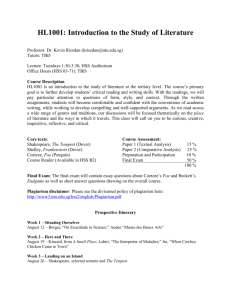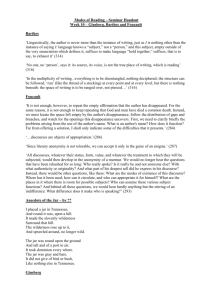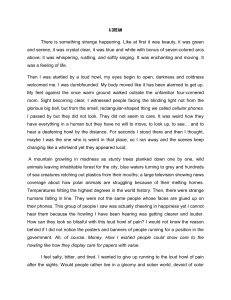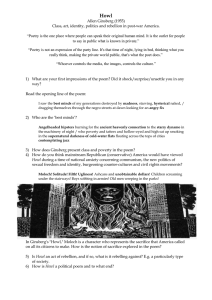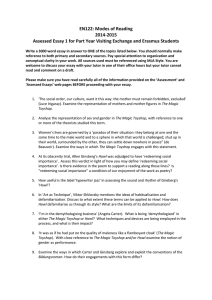Document 13466873
advertisement
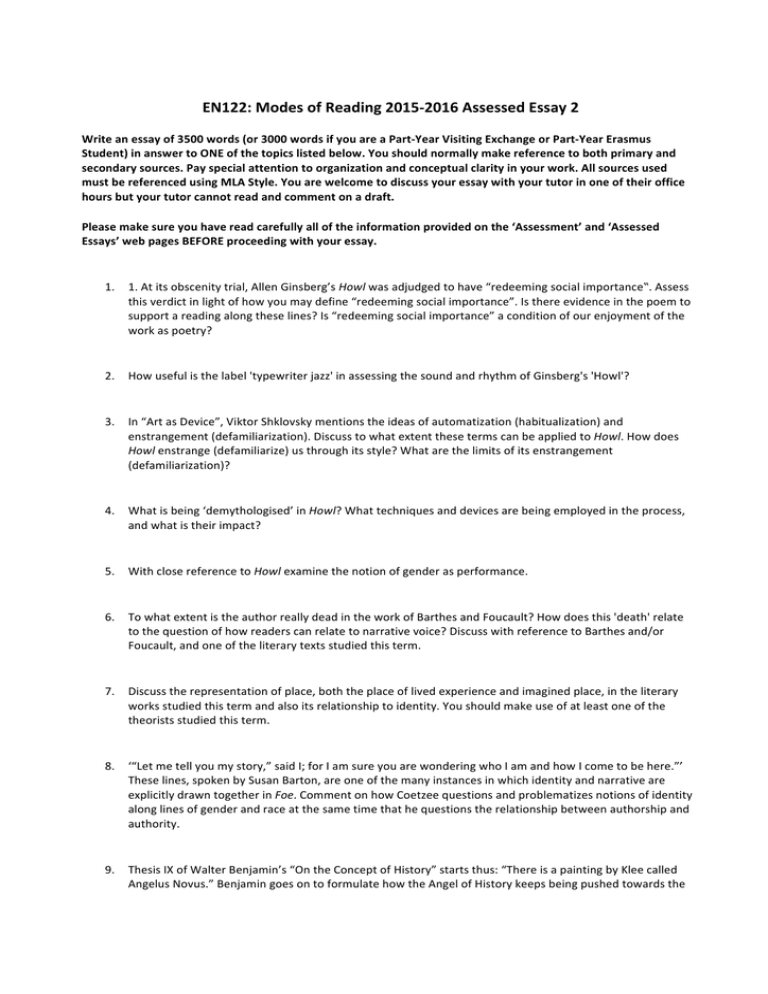
EN122: Modes of Reading 2015-­‐2016 Assessed Essay 2 Write an essay of 3500 words (or 3000 words if you are a Part-­‐Year Visiting Exchange or Part-­‐Year Erasmus Student) in answer to ONE of the topics listed below. You should normally make reference to both primary and secondary sources. Pay special attention to organization and conceptual clarity in your work. All sources used must be referenced using MLA Style. You are welcome to discuss your essay with your tutor in one of their office hours but your tutor cannot read and comment on a draft. Please make sure you have read carefully all of the information provided on the ‘Assessment’ and ‘Assessed Essays’ web pages BEFORE proceeding with your essay. 1. 1. At its obscenity trial, Allen Ginsberg’s Howl was adjudged to have “redeeming social importance‟. Assess this verdict in light of how you may define “redeeming social importance”. Is there evidence in the poem to support a reading along these lines? Is “redeeming social importance” a condition of our enjoyment of the work as poetry? 2. How useful is the label 'typewriter jazz' in assessing the sound and rhythm of Ginsberg's 'Howl'? 3. In “Art as Device”, Viktor Shklovsky mentions the ideas of automatization (habitualization) and enstrangement (defamiliarization). Discuss to what extent these terms can be applied to Howl. How does Howl enstrange (defamiliarize) us through its style? What are the limits of its enstrangement (defamiliarization)? 4. What is being ‘demythologised’ in Howl? What techniques and devices are being employed in the process, and what is their impact? 5. With close reference to Howl examine the notion of gender as performance. 6. To what extent is the author really dead in the work of Barthes and Foucault? How does this 'death' relate to the question of how readers can relate to narrative voice? Discuss with reference to Barthes and/or Foucault, and one of the literary texts studied this term. 7. Discuss the representation of place, both the place of lived experience and imagined place, in the literary works studied this term and also its relationship to identity. You should make use of at least one of the theorists studied this term. 8. ‘“Let me tell you my story,” said I; for I am sure you are wondering who I am and how I come to be here.”’ These lines, spoken by Susan Barton, are one of the many instances in which identity and narrative are explicitly drawn together in Foe. Comment on how Coetzee questions and problematizes notions of identity along lines of gender and race at the same time that he questions the relationship between authorship and authority. 9. Thesis IX of Walter Benjamin’s “On the Concept of History” starts thus: “There is a painting by Klee called Angelus Novus.” Benjamin goes on to formulate how the Angel of History keeps being pushed towards the future even as his face is turned towards the past. Please explain how you interpret Benjamin’s concept of progress and how it might be applied to the violence thematized by Coetzee in Foe. 10. Edward Said’s seminal work in Orientalism analyzes ways in which discourse can be used to oppress and colonize those deemed inferior. How do you see his views applying to a reading of Coetzee’s Foe? 11. Please examine the issue of racism and authority as exposed in Foe, drawing on two theorists read this term. 12. At the conclusion of his essay on “Racism’s Last Word” Derrida refers to the silence of the paintings assembled in the exhibition against Apartheid as just. Please explain how you view such a statement and how it might also be related to Coetzee’s Foe in general and Friday’s silence in particular.
